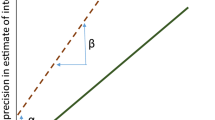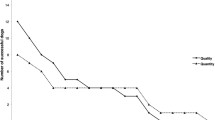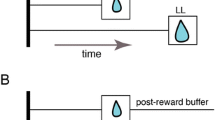Abstract
There is evidence that impulsive decision-making is associated with errors in timing. However, there has been little attempt to identify the putative mechanism responsible for impulsive animals’ timing errors. One means of manipulating impulsivity in non-human animals is providing different levels of access to conspecifics. These preclinical models have revealed that social isolation increases impulsive responding across a wide range of tasks. The goal of the present study was to determine whether social isolation modulates time perception in pigeons by inducing more variability or a bias to underestimate the passage of time in temporal judgments. A temporal bisection task was used to characterize time perception. One group of pigeons performed the bisection following social enrichment, and the remaining half of the pigeons were tested following social isolation. Results revealed pigeons in the social isolation condition categorized a temporal stimulus sample as “long” at shorter durations than pigeons in the social enrichment condition. These data highlight the mechanism(s) thought to underlie timing-based interventions aimed at reducing impulsivity in humans. Future work should consider whether impulsivity is produced by misperceptions of time or a reduced threshold for a response.



Similar content being viewed by others
Notes
Temporal memory was represented as the geometric mean of the end-point stimuli as suggested by some theories of timing (Killeen and Fetterman 1988; Gibbon et al. 1984; Allan and Gibbon 1991). Although there is still some debate on how time is represented psychologically (Trujano and Orduña 2015; Jozefowiez et al. 2009; Yi 2009), the outcome of our statistical tests on parameter estimates did not depend on whether we represented temporal memory as centered on the geometric, arithmetic, or harmonic mean of the end-point stimuli.
References
Allan LG, Gibbon J (1991) Human bisection at the geometric mean. Learn Moti 22(1):39–58
Allman MJ, Meck WH (2012) Pathophysiological distortions in time perception and timed performance. Brain 135:656–677
Aum SW, Brown BL, Hemmes NS (2004) The effects of concurrent task and gap events on peak time in the peak procedure. Behav Process 65(1):43–56
Avlar B, Kahn JB, Jensen G, Kandel ER, Simpson EH, Balsam PD (2015) Improving temporal cognition by enhancing motivation. Behav neurosci 129(5):576
Balci F (2014) Interval timing, dopamine, and motivation. Timing Time Percept 2:379–410
Barkley RA, Edwards G, Laneri M, Fletcher K, Metevia L (2001) Executive functioning, temporal discounting, and sense of time in adolescents with attention deficit hyperactivity disorder (ADHD) and oppositional defiant disorder (ODD). J Abnorm Child Psychol 29:541–556
Baumann AA, Odum AL (2012) Impulsivity, risk taking, and timing. Behav Process 90(3):408–414
Beckmann JS, Bardo MT (2012) Environmental enrichment reduces attribution of incentive salience to a food-associated stimulus. Behav Brain Res 226(1):331–334
Beckmann JS, Chow JJ (2015) Isolating the incentive salience of reward-associated stimuli: value, choice, and persistence. Learn Mem 22:116–127
Berry MS, Sweeney MM, Morath J, Odum AL, Jordan KE (2014) The nature of impulsivity: visual exposure to natural environments decreases impulsive decision-making in a delay discounting task. PLoS One 9(5):e97915
Berry MS, Repke MA, Nickerson NP, Conway LG III, Odum AL, Jordan KE (2015) Making time for nature: visual exposure to natural environments lengthens subjective time perception and reduces impulsivity. PLoS One 10(11):e0141030
Bickel WK, Marsch LA (2001) Toward a behavioral economic understanding of drug dependence: delay discounting processes. Addiction 96(1):73–86
Bizo LA, White KG (1997) Training with controlled reinforcer density: implications for models of timing. J Exp Psychol Anim Behav Process 23(1):44–55
Bozarth MA, Murray A, Wise RA (1989) Influence of housing conditions on the acquisition of intravenous heroin and cocaine self-administration in rats. Pharmacol Biochem Behav 33:903–907
Brenes JC, Fornaguera J (2008) Effects of environmental enrichment and social isolation on sucrose consumption and preference: associations with depressive-like behavior and ventral striatum dopamine. Neurosci Lett 436(2):278–282
Briones TL, Klintsova AY, Greenough WT (2004) Stability of synaptic plasticity in the adult rat visual cortex induced by complex environment exposure. Brain Res 1018:130–135
Buhusi CV, Meck WH (2005) What makes us tick? Functional and neural mechanisms of interval timing. Nat Rev Neurosci 6:755–765
Cheung TH, Neisewander JL, Sanabria F (2012) Extinction under a behavioral microscope: isolating the sources of decline in operant response rate. Behav Process 90:111–123
Church RM, Deluty MZ (1977) Bisection of temporal intervals. J Exp Psychol Anim Learn Cognit 3:216
Daniels CW, Sanabria F (2016) Interval timing under a behavioral microscope: dissociating motivational and timing processes in fixedinterval performance. Learn Behav. doi:10.3758/s13420-016-0234-1
Daniels CW, Watterson E, Garcia R, Mazur GJ, Brackney RJ, Sanabria F (2015a) Revisiting the effect of nicotine on interval timing. Behav Brain Res 283:238–250
Daniels CW, Fox AE, Kyonka EG, Sanabria F (2015b) Biasing temporal judgments in rats, Pigeons, and humans. Int J Comp Psychol
Dickinson A, Balleine B, Watt A, Gonzalez F, Boakes RA (1995) Motivational control after extended instrumental training. Learn Behav 23:197–206
Gautier T, Droit-Volet S (2002) Attention and time estimation in 5-and 8-year-old children: a dual-task procedure. Behav Process 58(1):57–66
Gibbon J, Church RM, Meck WH (1984) Scalar timing in memory. Ann NY Acad Sci 1:52–77
Gluck JP, Pearce HE (1977) Acquisition and extinction of an operant response in differentially reared rats. Dev Psychobiol 10:143–149
Halperin JM, Bédard ACV, Curchack-Lichtin JT (2012) Preventive interventions for ADHD: a neurodevelopmental perspective. Neurotherapeutics 9(3):531–541
Heerey EA, Robinson BM, McMahon RP, Gold JM (2007) Delay discounting in schizophrenia. Cognit Neuropsychiatry 12(3):213–221
Homer BD, Solomon TM, Moeller RW, Mascia A, DeRaleau L, Halkitis PN (2008) Methamphetamine abuse and impairment of social functioning: a review of the underlying neurophysiological causes and behavioral implications. Psychol Bull 134:301–310
Jones GH, Marsden CA, Robbins TW (1991) Behavioural rigidity and rule-learning deficits following isolation-rearing in the rat: neurochemical correlates. Behav Brain Res 43:35–50
Jozefowiez J, Staddon JER, Cerutti DT (2009) The behavioral economics of choice and interval timing. Psych Rev 116(3):519–539
Killeen PR, Fetterman JG (1988) A behavioral theory of timing. Psych Rev 95(2):274
Kirkpatrick K, Marshall AT, Clarke J, Cain ME (2013) Environmental rearing effects on impulsivity and reward sensitivity. Behav Neurosci 127:712–724
Laude JR, Beckmann JS, Daniels CW, Zentall TR (2014a) Impulsivity affects suboptimal gambling-like choice by Pigeons. J Exp Psychol Anim Learn Cognit 40:2–11
Laude JR, Stagner JP, Zentall TR (2014b) Suboptimal choice by Pigeons may result from the diminishing effect of nonreinforcement. J Exp Psychol Anim Learn Cognit 40:12–21
Lejeune H, Macar F, Zakay D (1999) Attention and timing: dual-task performance in Pigeons. Behav Process 45(1):141–157
Love J, et al (2015) JASP (Version 0.7) [Computer software]
Ludvig EA, Conover K, Shizgal P (2007) The effects of reinforcer magnitude on timing in rats. J Exp Anal Behav 87:201–218
Machado A (1997) Learning the temporal dynamics of behavior. Psychol Rev 104(2):241–265
Matheson SM, Asher L, Bateson M (2008) Larger, enriched cages are associated with ‘optimistic’ response biases in captive European starlings (Sturnus vulgaris). Appl Anim Behav Sci 109:374–383
McClure EA, Saulsgiver KA, Wynne CDL (2005) Effects of d-amphetamine on temporal discrimination in Pigeons. Behav Pharmacol 16:193–208
Meck WH (1996) Neuropharmacology of timing and time perception. Cognit Brain Res 3:227–242
Morgan MJ, Einon D, Morris RGM (1977) Inhibition and isolation rearing in the rat: extinction and satiation. Physiol Behav 18:1–5
Myung IJ (2003) Tutorial on maximum likelihood estimation. J Math Stat Psychol 47:90–100
Pattison KF, Laude JR, Zentall TR (2013) Environmental enrichment affects suboptimal, risky, gambling-like choice by Pigeons. Anim Cognit 16:429–434
Perry JL, Stairs DJ, Bardo MT (2008) Impulsive choice and environmental enrichment: effects of d-amphetamine and methylphenidate. Behav Brain Res 193:48–54
Plowright CMS, Church D, Behnke P, Silverman A (2000) Time estimation by Pigeons on a fixed interval: the effect of pre-feeding. Behav Process 52:43–48
Rakitin BC, Gibbon J, Penney TB, Malapani C, Hinton SC, Meck WH (1998) Scalar expectancy theory and peak-interval timing in humans. J Exp Psychol Anim Learn Cognit 24:15–33
Roesch MR, Calu DJ, Schoenbaum G (2007) Dopamine neurons encode the better option in rats deciding between differently delayed or sized rewards. Nat Neurosci 10(12):1615–1624
Sanabria F, Killeen PR (2008) Evidence for impulsivity in the spontaneously hypertensive rat drawn from complementary response-withholding tasks. Behav Brain Funct 8:4–7
Sanabria F, Thrailkill EA, Killeen PR (2009) Timing with opportunity cost: concurrent schedules of reinforcement improve peak timing. Learn Behav 37:217–229
Schultz W (2002) Getting formal with dopamine and reward. Neuron 36(2):241–263
Smith AP, Marshall AT, Kirkpatrick K (2015) Mechanisms of impulsive choice: II. Time-based interventions to improve self-control. Behav Processes 112:29–42
Solinas M, Chauvet C, Thiriet N, El Rawas R, Jaber M (2008) Reversal of cocaine addiction by environmental enrichment. Proc Natl Acad Sci U S A 105(44):17145–17150
Solinas M, Thiriet N, Chauvet C, Jaber M (2010) Prevention and treatment of drug addiction by environmental enrichment. Prog Neurobiol 92:572–592
Stairs DJ, Bardo MT (2009) Neurobehavioral effects of environmental enrichment and drug abuse vulnerability.”. Pharmacol Biochem Behav 92(3):377–382
Taylor KM, Horvitz JC, Balsam PD (2007) Amphetamine affects the start of responding in the peak interval timing task. Behav Process 74(2):168–175
Trujano RE, Orduña V (2015) Reducing bias and analyzing variability in the time-left procedure. Behav Process 113:132–142
Van den Broek MD, Bradshaw CM, Szabadi E (1992) Performance of impulsive and non-impulsive subjects on two temporal differentiation tasks. Pers Individ Dif 13:169–174
Ward RD, Johnson RN, Odum AL (2009) Effects of prefeeding, extinction, and distraction during sample and comparison presentation on sensitivity to reinforcer frequency in matching to sample. Behav Process 81:65–73
Wittmann M, Paulus MP (2008) Decision making, impulsivity and time perception. Trends Cognit Sci 12:7–12
Wittmann M, Leland DS, Churan J, Paulus MP (2007) Impaired time perception and motor timing in stimulant-dependent subjects. J Alcohol Drug Depend 90:183–192
Wooters TE, Bardo MT, Dwoskin LP, Midde NM, Gomez AM, Mactutus CF, Zhu J (2011) Effect of environmental enrichment on methylphenidate-induced locomotion and dopamine transporter dynamics. Behav Brain Res 219(1):98–107
Yi L (2009) Do rats represent time logarithmically or linearly? Behav Process 81(2):274–279
Yin HH, Knowlton BJ (2006) The role of the basal ganglia in habit formation. Nat Rev Neurosci 7:464–476
Acknowledgments
The first author is supported by a NIDA T32 DA 035165 postdoctoral fellowship. The content is solely the responsibility of the authors. The experiment complied with the current laws of the USA in which they were performed. We thank Dr. Federico Sanabria for his insights on modeling these data.
Author information
Authors and Affiliations
Corresponding author
Ethics declarations
Conflict of interest
All authors declare that they have no conflicts of interest. Authors have full control of all primary data and agree to allow the journal to review the data if requested.
Rights and permissions
About this article
Cite this article
Laude, J.R., Daniels, C.W., Wade, J.C. et al. I can time with a little help from my friends: effect of social enrichment on timing processes in Pigeons (Columba livia). Anim Cogn 19, 1205–1213 (2016). https://doi.org/10.1007/s10071-016-1032-z
Received:
Revised:
Accepted:
Published:
Issue Date:
DOI: https://doi.org/10.1007/s10071-016-1032-z




